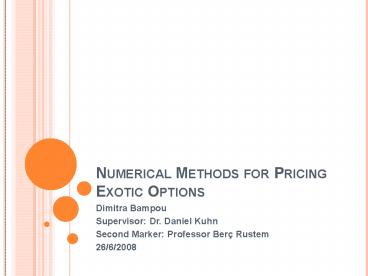Numerical Methods for Pricing Exotic Options - PowerPoint PPT Presentation
1 / 31
Title:
Numerical Methods for Pricing Exotic Options
Description:
Primal problems: infinitely many decision variables. Introduce dual variable y. Dual problems: infinitely many constraints. PROPOSITIONS BY BERTSIMAS & POPESCU ... – PowerPoint PPT presentation
Number of Views:407
Avg rating:3.0/5.0
Title: Numerical Methods for Pricing Exotic Options
1
Numerical Methods for Pricing Exotic Options
- Dimitra Bampou
- Supervisor Dr. Daniel Kuhn
- Second Marker Professor Berç Rustem
- 26/6/2008
2
Options
- Given a stock of Vodafone with price St
- Strike price K 50
- Maturity date T 1 year from now
- Premium 5
- European Call Option value
- Exotic options Asian Barrier
- Payoff of Asian Call option is
3
Profit Diagram Pricing Challenges
4
Standard Pricing Models
- Black Scholes model for European Options
- Assume risk neutral distribution
- Assume Geometric Brownian Motion
- No analytic solution for exotics
- Monte Carlo Simulations for Exotic Options
- Easily adapted
- Heavy computation
- Probabilistic errors
5
aim of the project
- Investigate two numerical methods for pricing
options based on semidefinite programming - Gotoh and Konno approach for pricing European
options (GK) - Method for pricing European, Asian and Barrier
options proposed by Lasserre, Prieto-Rumeau and
Zervos (LPZ) - The method is based on the Problem of Moments for
finding max/min of non convex functions - Numerical results comparison with standard
pricing models
6
Gotoh And Konno Approach
7
Formulating The Problem
- Want to find upper and lower bounds of a European
Call option - Since price of underlying is a process, use risk
neutral probability distribution to find its
expected value - Given the first few moments of that distribution
8
Dual Problems
- Primal problems infinitely many decision
variables - Introduce dual variable y
- Dual problems infinitely many constraints
9
Propositions By Bertsimas Popescu
- Proposition 1 Polynomial is
positive iff there is a positive semidefinite
matrix - such that
- Proposition 2 Polynomial is
positive iff there is a positive
semidefinite matrix such that
10
Improving The Dual Problems
- Use propositions to derive semidefinite
optimization problems - They are convex, with finite number of decision
variables finite number of constraints - Use interior point methods
11
The Problem of Moments
12
The Problem Of Moments
- Want to solve
- Or equivalently
- Express constraint using Moment and Localizing
matrices
13
Moment Matrix
- Introduce sequence
- Moment matrix is defined as
- Example, for n2,k2
14
Localizing Matrix
- Polynomial q with coefficients qa and set R
given by - subscript of y in the entry
- Localizing matrix is given by
- Example, for kn2 and
15
MOMENTS OF MEASURE µ
- If the elements of y are moments of measure µ and
p(x) is of order maximum k then
because - If the elements of y are moments of measure µ and
p(x) is of order maximum k then
because
16
The Problem of Moments (2)
- Now define the semidefinite optimization problem
- Expresses a non convex optimization problem into
a convex
17
Lasserre, Prieto-Rumeau and Zervos Approach
18
Asian Call Option
- Payoff function
- Underlying asset is an Ito process of the form
- Define processes
- Exit location measure corresponding to stopping
time t of Zt
19
Asian Call Option (2)
- Payoff function as a linear combination of the
moments of exit location measure
20
Asian Call Option (3)
- Formulate the problem
- where
21
European Barrier Options
- Derive similar problems for approximating upper
and lower bounds of European options - Can apply same problems for pricing put options
by changing the objective function - To calculate the moments of process Z, we use the
Itos lemma to obtain a system of ordinary
differential equations - To price barrier options, we use the
infinitesimal generator of process Z
22
Numerical Results
23
Lasserre, Prieto-Rumeau and Zervos
24
Lasserre, Prieto-Rumeau and Zervos(2)
- Variance of Monte Carlo simulation is 0.0047
- Distance between bounds for r3 is 0.0013
25
Lasserre, Prieto-Rumeau and Zervos(3)
- Non monotonic sequence of upper bounds
- Variance of Monte Carlo is 0.0056 with confidence
interval 0.1596,0.1781
26
Lasserre, Prieto-Rumeau and Zervos(4)
- Relative error of 0.24 at 3rd relaxation
27
Pricing Asian Options
28
Gotoh-Konno Approach
- Obtain tight upper and lower bounds in real time
- Must find a way to obtain moments of the
distribution of the price of underlying asset
29
Lasserre, Prieto-Rumeau and Zervos Method
- Flexible and can be easily extended to price
other exotic options - Can be applied to any type of processes for the
price of the underlying asset if its
infinitesimal generator maps polynomials into
polynomials - Tight bounds and less time required than Monte
Carlo simulations - Must ensure that the distribution of the
underlying asset is moment determinate to obtain
monotone sequences
30
Future Work
- Adapt the problem of moments for pricing other
types of exotic options - Explore the cutting plane algorithm proposed by
Gotoh and Konno for solving semidefinite
optimization problems
31
QA















![[Titolo] PowerPoint PPT Presentation](https://s3.amazonaws.com/images.powershow.com/P1258792262sBKzI.th0.jpg?_=20150411059)















